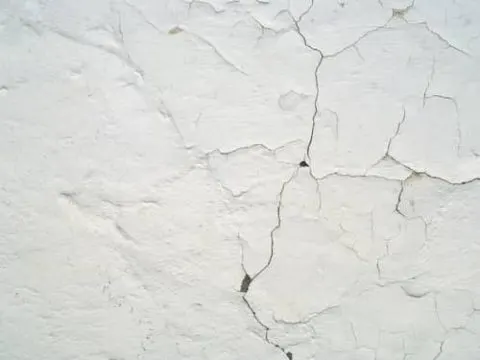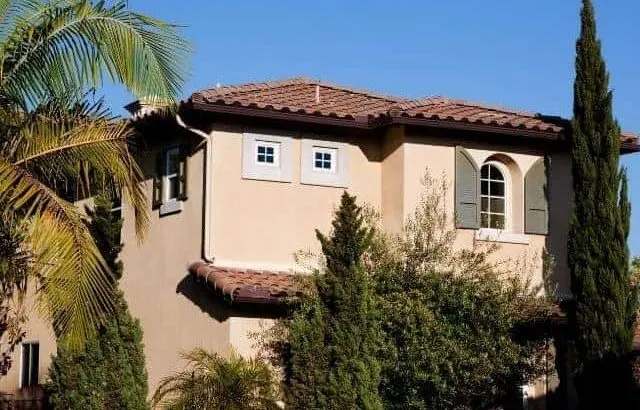If you take a drive through just about any part of Florida, you’re bound to see many stucco homes. And if you come from outside of the Southernmost parts of the United States, you’ll probably be surprised by just how much stucco you see.
Houses in Florida are made of stucco because stucco is fairly inexpensive, creates a great finished look, and is easy to apply to homes constructed with concrete blocks. It is less popular in some regions because it can be damaged as a house shifts and settles over time.
If you’re looking to buy property in Florida, most experts will tell you to proceed with caution on homes made with stucco siding. My wife and I considered purchasing a condo in Florida as a rental property at one point which had a stucco exterior.
It turns out that stucco can be a big problem for a home if it isn’t properly installed.
In this article, we’ll discuss the advantages and disadvantages of stucco siding and what to do if you have a home with stucco siding in Florida.
Why Are Houses In Florida Made Of Stucco?
It turns out that in many regions, stucco is a fantastic choice for siding. It has many advantages over any other type of siding. Let’s take a look at each of these advantages that make stucco a common choice in Florida.
Stucco is:
- Considered aesthetically pleasing by many. It creates a smooth, pulled-together look that is timeless. Features like stone can also easily be incorporated into the design.
- Made with easily accessed materials that are affordable. Although stucco creates a high-end look, it is made with relatively inexpensive materials like sand and lime.
- Durable when properly installed in the right region. As long as you take care of the stucco, and it was installed right in the first place, it will last your lifetime. Cracks can be repaired, and because the pigment is mixed into the stucco, it won’t become dull.
- Fire-resistant. FEMA recommends stucco as one of the most fire-resistance materials.
- Helpful in reducing noise. Stucco creates a buffer between outdoor sounds and the inside of your home. This is important if you live in a neighborhood or on a busy sheet.
- Good at insulating the home and reducing energy costs. Keeping a home cool in Florida can be a big expense. Stucco helps keep homes cooler in hot weather, which leads to energy savings.
But stucco does have some disadvantages, which we’ll talk about in the next section.
Why Do Some People Avoid Stucco Homes in Florida?
Stucco is not always a poor choice of siding, but in Florida, many people are regretting the stucco exterior of their homes because of some important disadvantages.
If you are considering a property in Florida or already have stucco on your home in Florida, be sure to take these in to account.
- Stucco is not waterproof. Stucco, like cement, is porous, which means that it is very easy for water to seep into it. In arid, desert climates, this isn’t a problem, but Florida is known for being humid and rainy.
- It can hide structural damage, mold, and termite infestation if it is not properly done. Once moisture gets behind the stucco, it can cause any one of these problems, and probably some combination of them. This is not an easy or inexpensive fix. Properly installed stucco will include a way for water to drain from behind the siding.
- It is not maintenance-free. Like most parts of a home, stucco requires some maintenance, especially in Florida, where delaying maintenance can lead to serious problems. Thankfully maintenance like filling cracks can often be done by the homeowner.
- Stucco requires a lot of labor to install. The materials needed to create stucco siding is not expensive, but installing it requires someone with the knowledge to do the job and a lot of time. The labor costs of stucco are greater than most other sidings.
- Stucco should not be power washed. Not only will using a power washer damage stucco siding, but it can also lead to unnecessary water seeping into its porous surface (source). This can make cleaning a little the exterior of a home a little more of a chore.
- Changing the color of stucco siding is more work. You can’t just paint stucco, or at least you shouldn’t. The paint job will look okay, but every time you need to repair the stucco, you’ll need to remove the paint with a sandblaster, repair the stucco, and then repaint it. To change the color of stucco, you’ll need to add a think coat of fresh stucco over the entire home.
Most people don’t mind that you can’t change the color easily or that you need to put in a little more elbow grease when washing the exterior of the home, but mold, termites, and structural damage to home raise serious red flags.
However, these aren’t problems in many homes with stucco. As long as the stucco was installed properly and has been maintained, the likelihood of a serious issue is slim.
Where Can Stucco Go Wrong?

There are several different ways in which stucco can be installed improperly. There isn’t just one thing that can go wrong; there are several. This is why it is important to hire a reputable and knowledgeable stucco installer to do the job.
Here are the most common ways that stucco is improperly installed:
- The stucco is too thin. Stucco has multiple layers, and it should be nearly an inch thick. If the layer of stucco isn’t thick enough, water damage is more likely as is cracking.
- No drainage. There must be a way for moisture that gets behind the stucco to drain away. This requires a weep screed, drainage mat, and a barrier between the stucco and the home.
- Flashing is installed poorly. Flashing around windows helps keep moisture outside of the house, and if it isn’t installed properly, it simply won’t do that job well. Discoloration under a window is often a sign of water damaged stucco.
- EIFS: Exterior insulation and finishing systems were often used when creating a stucco finish. The problem with this system is that it doesn’t provide drainage for water and instead traps it. They also tend to use materials that don’t hold up well when exposed to moisture (like plywood).
Beyond poor installation, stucco can go wrong if you don’t take extra care to fill cracks that appear. These cracks let water in, and that should be avoided at any cost.
Most homeowners can easily repair small cracks in stucco, or you can hire a professional. Just make sure they are knowledgeable and professional.
Is Stucco a Good Siding Choice for Florida Homes?
There is no siding that is one hundred percent waterproof. Houses need to breathe to maintain healthy air quality and moisture levels, so this isn’t necessarily bad.
Most of the problems with stucco come into play when the wrong contractor is hired to do the job. Or, on older homes, if it was installed 50 years ago, we didn’t know as much about the problems with stucco siding then.
When buying a home with stucco siding, the stucco must be inspected thoroughly by an expert.
As long as you hire a professional to complete the job, then stucco is a fine choice for a home in Florida. This is especially true if the home is made with cement blocks instead of wood because cement blocks aren’t as susceptible to water and pest damage.
However, many people avoid purchasing wood and stucco homes because it has a reputation for disaster. If you plan to resell your home in the near future, then a different siding choice will help your home sell more quickly.
As a homeowner, I am constantly experimenting with making the structure of my house more energy-efficient, eliminating pests, and taking on DIY home improvement projects. Over the past two decades, my family has rehabbed houses and contracted new home builds and I’ve learned a lot along the way. I share my hard-learned lessons so that you can save time and money by not repeating my mistakes.


Leave a comment
You must be logged in to post a comment.